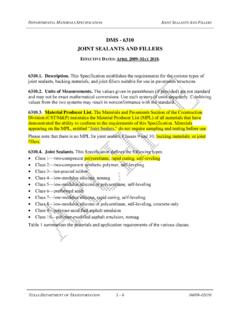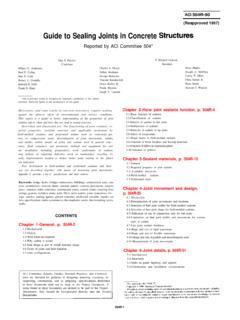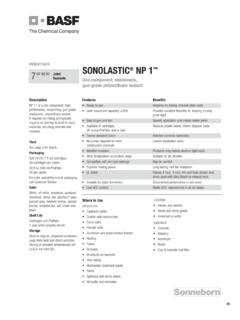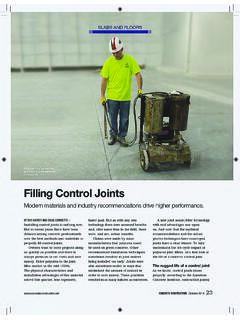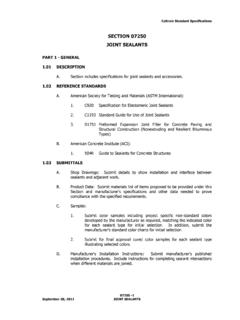Transcription of DMS - 6310 JOINT SEALANTS AND FILLERS
1 DEPARTMENTAL MATERIALS SPECIFICATION JOINT SEALANTS AND FILLERS TEXAS DEPARTMENT OF TRANSPORTATION 1 6 06/10 06/12 DMS - 6310 JOINT SEALANTS AND FILLERS EFFECTIVE DATES: JUNE 2010 JUNE 2012. Description. This Specification establishes the requirements for the various types of JOINT SEALANTS , backing materials, and JOINT FILLERS suitable for use in pavements structures. Units of Measurements. The values given in parentheses (if provided) are not standard and may not be exact mathematical conversions. Use each system of units separately. Combining values from the two systems may result in nonconformance with the standard. Material Producer List. The Materials and Pavements Section of the Construction Division (CST/M&P) maintains the Material Producer List (MPL) of all materials that have demonstrated the ability to conform to the requirements of this Specification.
2 Materials appearing on the MPL, entitled JOINT Sealers, do not require sampling and testing before use. Please note that there is no MPL for Class 9 and 10 JOINT sealers; backing materials; or JOINT FILLERS . National Transportation Product Evaluation Program (NTPEP). When a Class 3, 4, 5, 7, or 8 sealant submitted to CST/M&P is listed on the most recent NTPEP field evaluation report with an overall sealant condition rating of 2 or less, some NTPEP test results may be used in lieu of Department testing. Specfically: NTPEP flow test results may be used for Class 3 SEALANTS . NTPEP tack-free time, resilience, cone penetration at 77 F (25 C), and non-immersed bond test results at -20 F (-29 C) may be used for any class. NTPEP test results for tensile strength at 150% elongation may be used in lieu of Department tensile strength and 24-hr.
3 Extension test, but only if all NTPEP bond test results show no loss of adhesion. CST/M&P will perform tests required by this specification that are not performed by NTPEP. CST/M&P test results that do not meet the requirements of this specification will constitute failure of the material even if the test was also performed by NTPEP. JOINT SEALANTS . This Specification defines the following types: Class 1 two-component polyurethane, rapid curing, self-leveling Class 2 two-component synthetic polymer, self-leveling Class 3 hot-poured rubber Class 4 low-modulus silicone, nonsag Class 5 low-modulus silicone or polyurethane, self-leveling Class 6 preformed seals Class 7 low-modulus silicone, rapid curing, self-leveling DEPARTMENTAL MATERIALS SPECIFICATION JOINT SEALANTS AND FILLERS TEXAS DEPARTMENT OF TRANSPORTATION 2 6 06/10 06/12 Class 8 low-modulus silicone or polyurethane, self-leveling, concrete only Class 9 polymer-modified asphalt emulsion Class 10 polymer-modified asphalt emulsion, nonsag Table 1 summarizes the materials and application requirements of the various classes.
4 Table 1 JOINT sealant Applicability Features Classes 1 2 3 4 5 6 7 8 9 Material Polyurethane Synthetic Polymer Asphalt Silicone Silicone or Polyurethane Solid Silicone Silicone or Polyurethane Asphalt Emulsion1- or 2-component 21 21 1 1 1 1 21 1 1 1 Self-Leveling or Nonsag SL SL N/A NS SL N/A SL SL SL NS Primer Required Yes No No No No No Yes No No No Backer Rod Required Yes No No Yes Yes3 No Yes Yes3 No
5 No JOINT Type2 H ACS AC ACS AC CS CSH C AC AC 1. These materials must cure by chemical reaction and not by evaporation of solvent or fluxing of harder particles. 2. JOINT Types: A = asphalt-to-concrete; C = concrete-to-concrete; S = steel or armored; H = header-type. Use with JOINT types other than the ones listed only after evaluating the sealant for the proposed application. 3. Unless otherwise shown on the plans. A. Liquid and Semisolid Types. Except for Class 6, each of the classes listed in Table 1 consists of a one- or two-component liquid or semisolid compound that is poured into the JOINT and solidifies after application.
6 1. Material Properties. Class 1 must meet ASTM C 920 Type M, Grade P, Class 50. For adhesion and cohesion under cyclic movement and adhesion-in-peel tests, the substrate will be the elastomeric header material corresponding to the header-type JOINT system that utilizes the sealant . Class 2 must cure sufficiently to not pick up under the wheels of traffic after a maximum of 24 hr. at an average temperature of 77 2 F (25 1 C), unless another time is specified. (Three hours is commonly used.) Class 3 consists of a rubber-modified asphalt compound which, when heated to the manufacturer's recommended temperature, will melt to an appropriate consistency for pouring and then solidify when cooled to ambient temperatures. Classes 2 and 3 must meet the requirements of Table 2.
7 DEPARTMENTAL MATERIALS SPECIFICATION JOINT SEALANTS AND FILLERS TEXAS DEPARTMENT OF TRANSPORTATION 3 6 06/10 06/12 Table 2 Synthetic and Bituminous Properties Material Class 2 Class 3 Property Test Method Min Max Min MaxWater content, % by mass Tex-501-C - 5 - - Cone Penetration, 150 g, 5 sec., 77 F (25 C), 48 hr. cure1 ASTM D 5329 - 130 - 90 Flow at 140 F (60 C), 5 hr., mm - - - 3 Flow at 158 F (70 C), 5 hr., 24 hr. cure, mm - 0 - - Resilience, 48 hr. cure1, % 50 - 60 - Resilience, oven aged, 5 hr. at 158 F (70 C), % 50 - - - Bond test, in. ( mm) wide, 50% extension, 3 cycles at 20 F (-29 C), 48 hr. cure ASTM D 53292,3 pass4 pass4 1.
8 For Class 3, use 12-hr. cure time. 2. If sealing joints other than asphalt or concrete, use test blocks of the specified material. 3. Exception to ASTM D 5329: For Class 2, use spacer blocks to form a specimen 2 in. long by in. wide by in. deep ( mm long by mm wide by mm deep) as described in ASTM C 719, Section 4. No evidence of cracking, separation, or other opening that is over 1/8 in. (3 mm) deep at any point in the sealer or between the sealer and the test blocks. Classes 4 and 7 must be silicone compounds. Classes 5 and 8 may be of either silicone or polyurethane. Classes 4, 5, 7, and 8 must meet the requirements of Table 3. Table 3 Silicone and Polyurethane Properties Material Class 4 Class 5 Class 7 Class 8 Property Test Method MinMax MinMax Min Max MinMaxFlow at room temperature, mm Tex-525-C - 5 - - - - - - Nonvolatile content, % - - 93 - 93 - 93 - Tack-free time, minutes ASTM C 6791 35 75 - 180 30 60 - 180 Extrusion Rate.
9 G/min ASTM C 11832 90 250 - - - - - - Tensile Strength and 24-hr. Extension Test: Tex-525-C Initial cure time, days - 3 6 2 6 Strength after air curing only, psi - 10 50 3 10 4 30 4 30 Strength after water immersion, psi - 10 50 3 10 4 30 4 30 Strength after oven aging, psi - 10 50 3 10 4 30 4 30 Strength after bond test.
10 Psi - 10 50 3 10 4 30 4 30 24-hr. extension test, all specimens - pass pass pass pass 1. Exception to ASTM C 1183: Use 90 5 psi (620 35 kPa) pressure for the air supply. DEPARTMENTAL MATERIALS SPECIFICATION JOINT SEALANTS AND FILLERS TEXAS DEPARTMENT OF TRANSPORTATION 4 6 06/10 06/12 Classes 9 and 10 must be single-component, polymer-modified emulsions composed primarily of a semisolid asphalt base, water, and an emulsifying agent and must meet the requirements of Table 4. Table 4 Emulsion Properties Material Class 9 Class 10 Property Test Method Min Max Min Max Apparent viscosity, 77 F (25 C), Pa*s ASTM D 2196, Method A 30 70 150 300 Vertical slump, 77 F (25 C), mm ASTM C 639 - - - 3 Residue by evaporation, % Tex-543-C 65 - 65 - Tests on Residue from Evaporation: Penetration, 77 F (25 C), 100 g, 5 sec.
